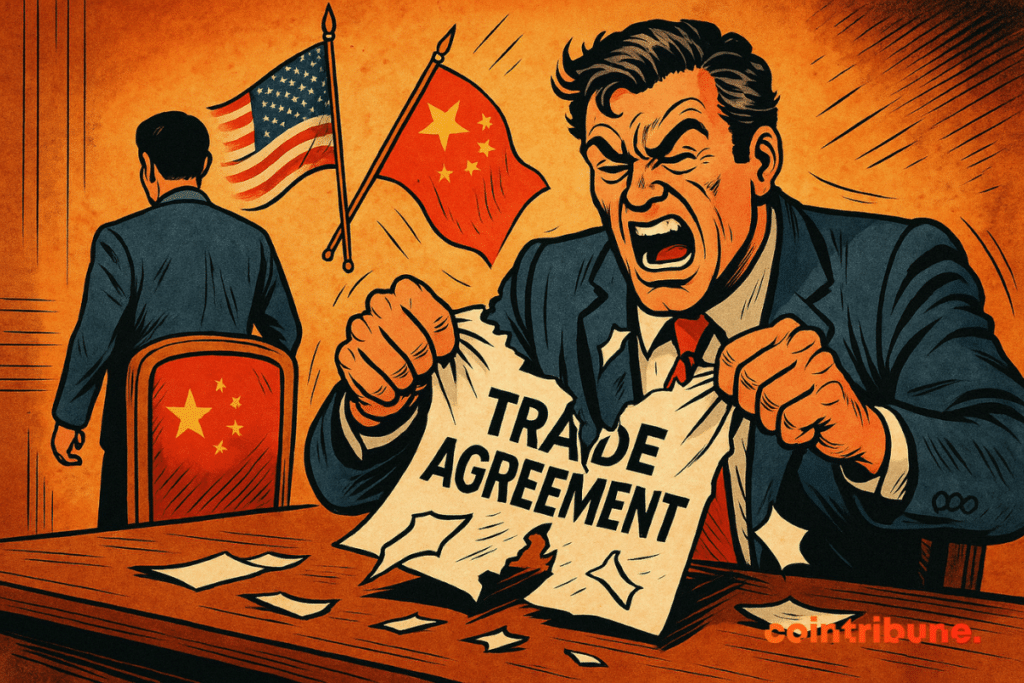19h05 ▪
4
min read ▪ by
China hoped to restore its economic image through gestures of appeasement towards the United States. Alas, despite a partial reduction in tariffs, the outlook remains bleak. The Chinese economy is faltering, trapped by its own inertia and a chilling global situation.


In brief
- The tariff reduction between Beijing and Washington has not revived the Chinese economy, which is still struggling.
- Between falling exports, slow restart, and a frozen global market, China is faltering.
- Faced with a chilling situation, Beijing hesitates, and investors lose confidence.
Chinese Economy: A Tariff De-escalation with a Bitter Taste
One might have expected a breath of optimism. A refreshing breath in a climate weighed down by years of Sino-American trade tension.
But the recent tariff reductions initiated between Beijing and Washington turned out to be nothing more than a mirage in a desert of uncertainties. The Chinese economy, far from lifting its head, is sinking into a dead end where recovery struggles to emerge.
On the surface, détente seems real. The two giants have apparently softened their positions. Yet, behind their diplomatic smiles, the trade machinery remains jammed.
Analysts at BCA Research don’t mince words: a genuine, durable, and structuring trade agreement is not coming any time soon. Worse yet, the effects of the tariff de-escalation seem insignificant compared to the severity of the headwinds.
China faces a triple barrier: a forecasted contraction in exports, significant delays in stimulus policies, and growth that no longer convinces anyone.
The economy, long touted as the driving force behind China’s rise, now seems to be slowing down despite signals of tariff peace. A peace that’s too mild, too late.
Growth Trapped Between Political Caution and Market Realities
What’s at stake here goes beyond tariffs. Behind accounting lines and forecasts lies an economic strategy that is running out of steam.
Beijing, long master of its trajectory, now seems to struggle to contain a global dynamic beyond its control. The slowdown in international trade spares no one, but hits China with particular intensity.
The indicators are there, cold and relentless. Exports are declining, order books are emptying, investment intentions are collapsing. Meanwhile, Beijing hesitates.
The expected stimulus measures—fiscal, monetary, structural—are arriving drip by drip, when they do not remain dead letters. Result: markets, which had heavily bet on a quick recovery, are beginning to lose hope. Meanwhile, BTC holds firm.
Analysts warn: Chinese stocks have not yet factored in the reality of degraded growth. Estimated profits could melt away like snow in the sun, reminiscent of the 2018-2019 trade war.
But this time, without the powerful lever of a state ready to spend without counting. The Chinese economy, despite its giant appearance, is walking on eggshells. It’s tempting to believe the Chinese economy will rebound, as it often has. But this time, the context is unprecedented.
The global situation is worsening, the dollar threatens to gain ground, and investors flee risk like the plague. Beijing, for now, seems to hesitate between political caution and economic necessity. An unstable balance that could well hasten the Chinese economy into a prolonged period of weakness.
Maximize your Cointribune experience with our “Read to Earn” program! For every article you read, earn points and access exclusive rewards. Sign up now and start earning benefits.


Fascinated by Bitcoin since 2017, Evariste has continuously researched the subject. While his initial interest was in trading, he now actively seeks to understand all advances centered on cryptocurrencies. As an editor, he strives to consistently deliver high-quality work that reflects the state of the sector as a whole.
DISCLAIMER
The views, thoughts, and opinions expressed in this article belong solely to the author, and should not be taken as investment advice. Do your own research before taking any investment decisions.

